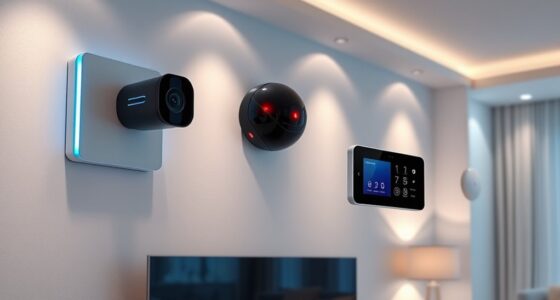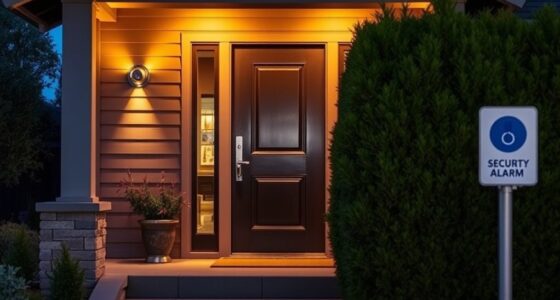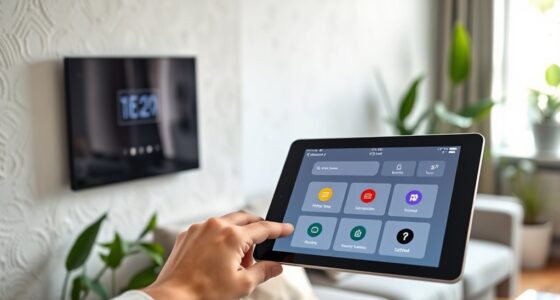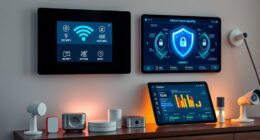Choosing between DIY and professional home security depends on your budget, technical skills, and security needs. DIY systems are affordable, easy to install, and flexible, but may require more maintenance. Professional systems cost more upfront but offer expert installation, advanced features, and ongoing monitoring. Think about what’s most important—cost, convenience, or technology—and explore the details below to find the best fit for your home and peace of mind.
Key Takeaways
- DIY systems are cost-effective, easy to install, and customizable, suitable for basic needs and budget-conscious homeowners.
- Professional systems offer expert installation, advanced features, and 24/7 monitoring, ideal for larger or high-security homes.
- DIY setups require some technical skills and ongoing maintenance, while professional systems provide reliability and comprehensive support.
- Consider your budget, security priorities, and comfort with technology to determine the best fit.
- Long-term costs and potential system reliability issues influence whether DIY or professional options are more suitable.
Understanding the Cost Differences Between DIY and Professional Systems

When choosing between DIY and professional home security systems, understanding their cost differences is essential.
DIY systems usually have lower upfront costs, ranging from $120 to $500 for equipment, and often don’t require monthly monitoring fees if you self-monitor. You can customize and expand DIY setups easily, purchasing only what you need, which helps control expenses.
DIY home security systems offer affordable upfront costs and easy customization without mandatory monthly fees.
In contrast, professional systems tend to have higher initial costs but include extensive support, warranties, and professional monitoring services that typically cost $20 to $40 monthly. Installation fees for DIY are minimal since you install the system yourself, while professional installations can add $80 to $100.
Over time, DIY options may be more affordable due to fewer ongoing charges, but professional systems offer added support and features that could justify their higher costs.
Installation Processes and Their Impact on Security
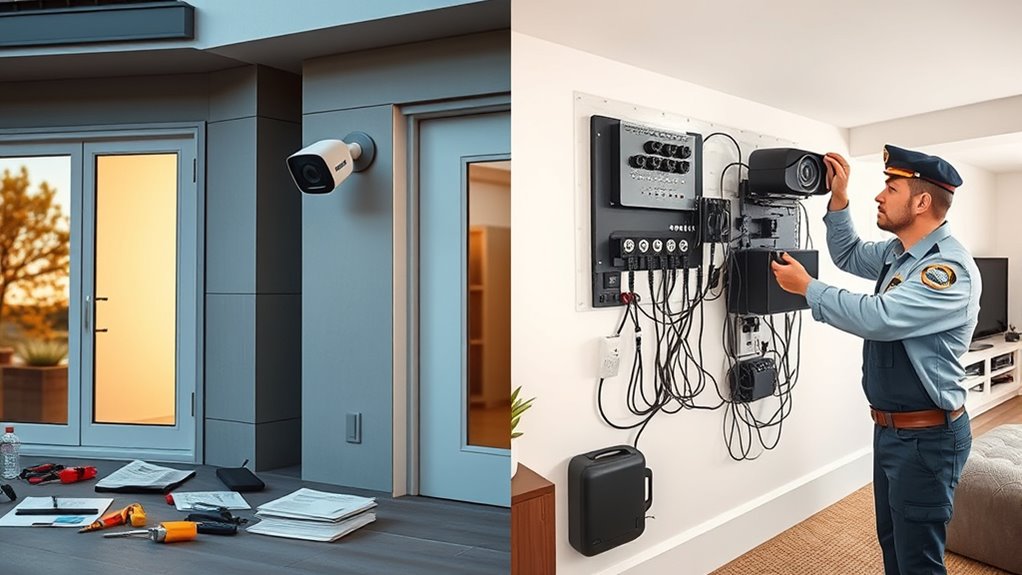
The way a home security system is installed substantially influences its overall effectiveness and reliability. DIY systems offer flexible installation options, allowing you to set up the system on your schedule with minimal tools, often just a screwdriver. They’re generally simpler to install, typically wireless, and don’t require extensive wiring, making the process quick and accessible for beginners. However, your success depends on your technical skills and attention to detail, as errors can lead to vulnerabilities. Professional installations involve experts evaluating your home’s specific needs, using specialized tools and wiring, and conducting thorough testing to ensure everything functions correctly. While this process takes longer, it results in a more reliable, airtight setup that minimizes user error, ultimately enhancing your home’s security. Proper installation processes can also involve the use of specialized tools and techniques, ensuring the system integrates seamlessly with your home infrastructure. Additionally, a professional setup can include comprehensive security assessments, which help identify potential weak points before installation. Furthermore, data-driven strategies employed during professional installation can optimize system placement and performance, providing an added layer of security. Incorporating these strategies can also help in detecting vulnerabilities early, preventing potential security breaches before they occur. Moreover, understanding the local regulations related to security system installations can ensure compliance and avoid legal issues.
Customization Options for Your Home Security System

Customization options allow you to tailor your home security system to fit your specific needs and preferences. With DIY systems, you start with basic components like a base station and keypad, then add sensors such as door/window contacts, motion detectors, or glass break sensors. Many DIY setups also integrate with smart home devices, offering automation features. You can easily scale your system by adding or removing components as your needs change, all without professional help. Additionally, DIY systems often provide cost-effective solutions that can be easily upgraded or modified without costly professional assistance. They also allow for a high degree of flexibility, letting you customize the system layout to suit your property. This adaptability makes DIY options particularly appealing for those seeking a personalized security plan. Professional systems, on the other hand, offer expert evaluations to customize the setup precisely for your property’s unique risks. They provide advanced sensors, personalized alerts, and seamless smart home integration. Both options enable you to create a security system that aligns with your lifestyle, but professional customization often offers a more tailored, extensive approach. Furthermore, some professional systems incorporate advanced technologies, such as AI-driven threat detection, which can enhance overall security. Adding professional consultation can help identify vulnerabilities you might overlook, ensuring comprehensive protection.
Monitoring Choices: Self-Monitoring vs. Professional Monitoring
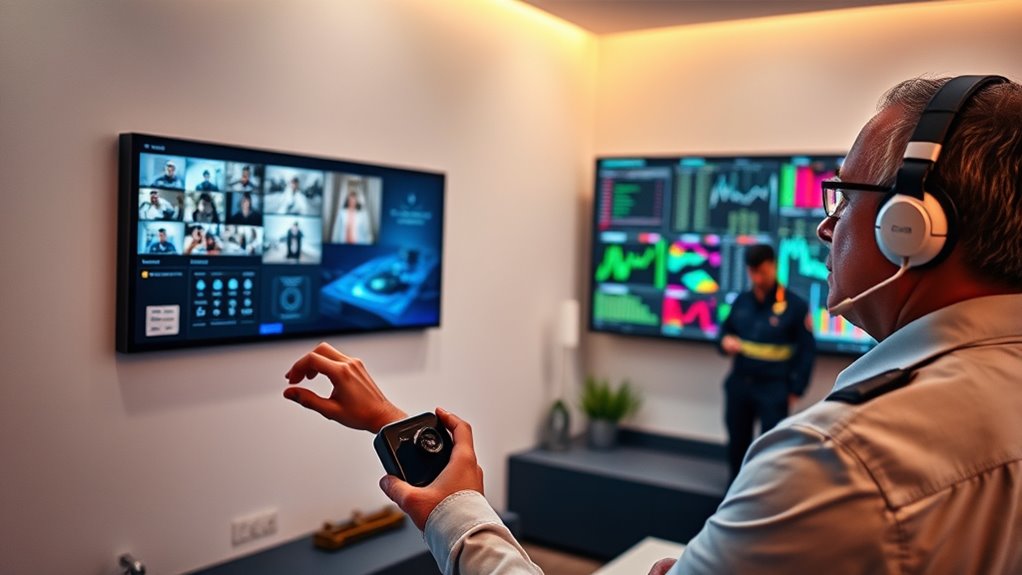
Choosing between self-monitoring and professional monitoring depends on your budget, lifestyle, and safety preferences. Self-monitoring is more affordable and gives you control, with DIY installation and mobile apps to manage alerts. However, you’re responsible for responding to alarms and contacting emergency services. It’s ideal if you’re comfortable handling your system and want to save on monthly fees. Additionally, understanding vetted safety products can help you select the most reliable equipment for your setup. Many DIY kits now feature wireless technology, making installation simpler and more adaptable to different home layouts. Some systems also include remote access, allowing you to monitor your home from anywhere using your smartphone. When selecting equipment, it’s important to consider breed-specific features that may enhance your security setup. Incorporating automated alert systems can further improve response times and reliability. Professional monitoring provides 24/7 oversight by trained agents, offering peace of mind and automated emergency responses. While it costs more, it ensures quick response times and reduces false alarms. If you prioritize constant protection and professional support, this option suits you. Both choices feature advanced sensors and smart home integration, but your decision hinges on how much responsibility and cost you’re willing to accept for your home’s security.
Reliability and Security: What You Need to Know

Reliability is a critical factor when it comes to home security systems, as even a small failure can leave your home vulnerable. False alarms are common, with about 62% of owners experiencing them annually, which can diminish trust in your system.
Reliability in home security is vital; even minor failures can compromise your home’s safety.
Cellular monitoring is more dependable than VOIP or landline connections, reducing disruptions. However, traditional systems reliant on landlines or internet can face downtime during outages, compromising security.
Regular maintenance and proper device integration are essential to keep your system functioning effectively. Incompatibilities between devices can cause reliability issues if not addressed.
To maximize security, choose systems with proven connectivity, ensure regular upkeep, and opt for professional installation if needed. This approach helps safeguard your home against potential failures.
Technical Skills and Ease of Setup

Setting up a home security system can vary considerably in complexity depending on whether you opt for a DIY solution or hire professionals.
DIY systems are designed to be user-friendly, often featuring plug-and-play devices and step-by-step guides that can be installed in less than an hour. Many systems come with online tutorials, manuals, and support lines to help beginners troubleshoot issues.
You may need some technical know-how for tasks like Wi-Fi setup or device compatibility, but overall, the process tends to be manageable. Floating on water concepts like wireless connectivity and sensor placement can also influence the ease of installation. Additionally, understanding projectors’ technology and how they integrate with home systems can be beneficial for optimal setup.
In contrast, professional systems are more complex and involve wired components, requiring expert installation. While this can be more challenging, it ensures proper integration and reduces the risk of setup errors, especially for sophisticated, integrated security solutions.
Long-Term Expenses and Maintenance Considerations

Long-term expenses and maintenance considerations play a crucial role in deciding between DIY and professional home security systems. DIY setups usually have lower upfront costs, ranging from $150 to $300, and no installation fees. However, you’ll handle maintenance and repairs yourself, which can be time-consuming and potentially costly if equipment fails. Warranty coverage is often limited, so repairs or replacements come out of your pocket. Additionally, security system reliability can be compromised if issues arise during troubleshooting, affecting your home’s safety. Regular system updates are necessary to ensure continued protection and effectiveness over time. Choosing a system with professional monitoring can provide added security and peace of mind, especially during troubleshooting or system failures. Ongoing maintenance, equipment repairs, and potential hidden costs should be considered, as DIY systems can leave your home vulnerable during troubleshooting periods. Furthermore, understanding monitoring options and their associated costs can help you make a more informed decision about which security setup best fits your long-term needs.
Features and Technology: What Each System Offers

When choosing between DIY and professional home security systems, understanding the features and technology each offers is essential. DIY systems are customizable, allowing you to add or remove components based on your needs, and are easy to install with minimal technical skills. They often include wireless cameras, real-time monitoring via mobile apps, and cloud storage options. Some even feature AI-powered surveillance and smart hubs for integrated control. AI Security technologies are increasingly integrated into modern security systems, enhancing their effectiveness and responsiveness.
Professional systems, on the other hand, provide exhaustive monitoring with advanced sensors, integrated alarms, and video verification to confirm threats. They use more sophisticated technology, including backup power sources and regular updates, and often connect directly to emergency services. While DIY solutions are flexible and cost-effective, professional setups tend to offer greater reliability, speed, and support.
Assessing Your Personal Comfort and Security Priorities

Choosing between DIY and professional home security systems depends heavily on your personal comfort level and security priorities.
Deciding between DIY and professional security depends on your comfort level and security needs.
If you’re comfortable with technology and don’t mind dedicating time to installation and maintenance, a DIY system might suit you best. However, keep in mind that DIY setups can be prone to errors, which could compromise your security.
If you prefer a system with reliable performance, faster response times, and ongoing support, a professional system might be more appropriate.
Consider how much physical effort you’re willing to invest in installation and whether you value customization or privacy.
Your comfort with managing tech issues and your priorities around security, privacy, and ease of use will guide you in choosing the system that best aligns with your needs.
Making the Right Choice for Your Home and Budget

Deciding between DIY and professional home security systems ultimately depends on your budget and specific needs.
If you want to save upfront costs and enjoy simple installation, a DIY system might suit you, especially if your home is small or your security needs are basic. However, keep in mind that DIY setups often lack advanced features and may require ongoing maintenance and troubleshooting.
On the other hand, professional systems typically come with higher initial costs but offer expert installation, reliable equipment, and exhaustive support. They’re better suited for larger homes or those seeking advanced automation and stronger security.
Consider your budget, technical comfort, and the level of security you require to make the best choice for your home.
Frequently Asked Questions
Can DIY Security Systems Be Integrated With Smart Home Devices?
You can definitely integrate DIY security systems with smart home devices. Many systems support popular voice assistants like Alexa and Google Home, allowing you to control your security with voice commands.
Some, like Abode, also support Zigbee, Z-Wave, and Apple HomeKit, giving you more customization options. Just keep in mind that compatibility varies, and setting up multiple integrations might take some time and technical effort.
What Are the Legal Considerations for Self-Installed Security Cameras?
Did you know over 70% of homeowners install security cameras themselves? When installing your own security cameras, you must follow privacy laws—avoid pointing cameras at private areas and get consent if recording conversations.
Keep cameras within your property boundaries, and don’t invade neighbors’ privacy. Also, comply with local and federal regulations, provide clear notices, and handle footage securely.
Staying informed helps you avoid legal trouble and protects your privacy rights.
How Does the Response Time Differ Between DIY and Professional Systems?
You notice that response times vary markedly between DIY and professional systems. DIY setups often rely on your actions and app notifications, which can delay intervention.
In contrast, professional systems typically have faster response times, usually between 15 and 45 seconds, thanks to dedicated monitoring centers.
Factors like connectivity, system setup, and provider quality influence these times, making professional systems generally more immediate and reliable in emergencies.
Are There Hidden Costs Associated With Professional Home Security Setups?
You should watch out for hidden costs with professional home security setups. These can include activation or setup fees, maintenance plans, and charges for system upgrades or repairs.
Also, some contracts lock you in with early termination penalties. While the initial price might seem clear, these additional expenses can add up over time, so make sure you understand all potential charges before committing to a professional system.
How Often Should Security Systems Be Updated or Maintained?
Oh, sure, just ignore maintenance and updates—who needs reliable security? You should service your system at least once a year, test it monthly, and update every 10-15 years to keep up with tech.
Skimping on this invites trouble, leaving you vulnerable. Regular check-ups prevent costly failures, and upgrades boost security.
Don’t wait for disaster; stay vigilant and keep your system sharp—your safety depends on it.
Conclusion
Choosing between DIY and professional security systems depends on your budget, comfort level, and security needs. Weigh the costs, installation, and monitoring options carefully—there’s no one-size-fits-all. Remember, it’s better to be safe than sorry, so pick a system that gives you peace of mind without breaking the bank. Ultimately, the right choice keeps your home secure and your stress levels down, so don’t rush—choose wisely and sleep soundly tonight.



